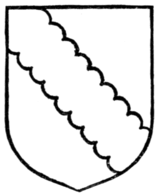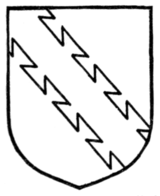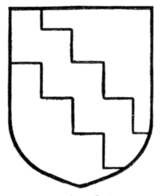THE SO-CALLED ORDINARIES
111
A bend is, of course, subject to the usual variations of the lines of partition (Figs. 66-75).
A bend compony (Fig. 76), will be found in the arms of Beaumont, and the difference between this (in which the panes run with the bend) and a bend barry (in which the panes are horizontal, Fig. 77), as in the arms of King,[1] should be noticed.
A bend wavy is not very usual, but will be found in the arms of Wallop, De Burton, and Conder. A bend raguly appears in the arms of Strangman.
- ↑ Armorial bearings of Sir Henry Seymour King, K.C.I.E.: Quarterly, argent and azure, in the second and third quarters a quatrefoil of the first, over all a bend barry of six of the second, charged with a quatrefoil also of the first, and gules.









